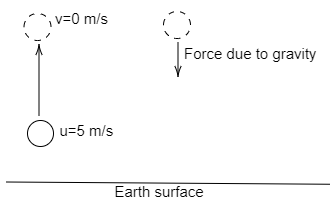
A particle of mass 100g is thrown vertically upwards with a speed of $5\;m{s^{ - 1}}$. What is the work done by the force of gravity during the time the particle goes up?
A. $ - 0.5\;J$
B. $ - 1.25\;J$
C. $1.25\;J$
D. $0.5\;J$
Answer
575.7k+ views
Hint: When a particle of a certain mass is thrown vertically upward with a certain speed. Then the kinetic energy at projection point is converted as the potential energy of the particle while rising. Potential energy is based on mass, gravity and height.
Formula used:
Work done on the mass formula:
$w = m.g.h$
Where ${w}$ is the work done against the force
$m$ is the mass of the object
$h$ is the height (or) position
$g$ is the acceleration due to gravity.
Complete step by step solution:
Mass of the object $\left( m \right) = 100\;g$
Vertical speed of the object $\left( u \right) = 5\;m{s^{ - 1}}$
When the object is raised from the ground, the work is done against the gravitational force, the work done on the mass is given by
${w_g} = m.g.h\;..........\left( 1 \right)$
Where,
${w_g}$ is the work done against the force
$m$ is the mass of the object
$h$ is the height (or) position
$g$ is the acceleration due to gravity.

Substitute the known value in (1)
${w_g} = \left( {100 \times {{10}^{ - 3}}} \right) \times 9.81 \times h\;.........\left( 2 \right)$
$\therefore $Acceleration due to gravity, $g = 9.81$ m/$s^2$
The vertical height to which the particle gets rise is $h$
So,
$h = \dfrac{{{u^2}}}{{2g}}$
Where
$u$ is the initial velocity
$g$ is the acceleration due to gravity.
By substituting the known values
$
h = \dfrac{{{{\left( 5 \right)}^2}}}{{2 \times 9.8}} = 1.27\;m \\
h = 1.27\;m \\
$
Substitute the value of height $h$ in equation (2)
$
{w_g} = \left( {100 \times {{10}^{ - 3}}} \right) \times 9.81 \times 1.27 \\
{w_g} = 1.25\;J \\
$
Since the work ${w_g}$ is done against the gravitation force.it is negative
Then,
$
- {w_g} = 1.25\;J \\
{w_g} = - 1.25\;J \\
$
$\therefore$ The work done by the force of gravity during the time the particle goes up is $ - 1.25\;J$. Hence, the options (B) is correct.
Note:
When in the absence of air resistance all the objects which are in free fall will hit the ground at the same time regardless of the mass of the substance. Actually, the acceleration due to gravity is always negative, that is $ - 9.81\;m{s^{ - 2}}$. But when the symbol $g$ is used in any of the equations, the direction will be assumed and the absolute value will be used for calculations as $\left( { + 9.81\;m{s^2}} \right)$.
Formula used:
Work done on the mass formula:
$w = m.g.h$
Where ${w}$ is the work done against the force
$m$ is the mass of the object
$h$ is the height (or) position
$g$ is the acceleration due to gravity.
Complete step by step solution:
Mass of the object $\left( m \right) = 100\;g$
Vertical speed of the object $\left( u \right) = 5\;m{s^{ - 1}}$
When the object is raised from the ground, the work is done against the gravitational force, the work done on the mass is given by
${w_g} = m.g.h\;..........\left( 1 \right)$
Where,
${w_g}$ is the work done against the force
$m$ is the mass of the object
$h$ is the height (or) position
$g$ is the acceleration due to gravity.

Substitute the known value in (1)
${w_g} = \left( {100 \times {{10}^{ - 3}}} \right) \times 9.81 \times h\;.........\left( 2 \right)$
$\therefore $Acceleration due to gravity, $g = 9.81$ m/$s^2$
The vertical height to which the particle gets rise is $h$
So,
$h = \dfrac{{{u^2}}}{{2g}}$
Where
$u$ is the initial velocity
$g$ is the acceleration due to gravity.
By substituting the known values
$
h = \dfrac{{{{\left( 5 \right)}^2}}}{{2 \times 9.8}} = 1.27\;m \\
h = 1.27\;m \\
$
Substitute the value of height $h$ in equation (2)
$
{w_g} = \left( {100 \times {{10}^{ - 3}}} \right) \times 9.81 \times 1.27 \\
{w_g} = 1.25\;J \\
$
Since the work ${w_g}$ is done against the gravitation force.it is negative
Then,
$
- {w_g} = 1.25\;J \\
{w_g} = - 1.25\;J \\
$
$\therefore$ The work done by the force of gravity during the time the particle goes up is $ - 1.25\;J$. Hence, the options (B) is correct.
Note:
When in the absence of air resistance all the objects which are in free fall will hit the ground at the same time regardless of the mass of the substance. Actually, the acceleration due to gravity is always negative, that is $ - 9.81\;m{s^{ - 2}}$. But when the symbol $g$ is used in any of the equations, the direction will be assumed and the absolute value will be used for calculations as $\left( { + 9.81\;m{s^2}} \right)$.
Recently Updated Pages
Why are manures considered better than fertilizers class 11 biology CBSE

Find the coordinates of the midpoint of the line segment class 11 maths CBSE

Distinguish between static friction limiting friction class 11 physics CBSE

The Chairman of the constituent Assembly was A Jawaharlal class 11 social science CBSE

The first National Commission on Labour NCL submitted class 11 social science CBSE

Number of all subshell of n + l 7 is A 4 B 5 C 6 D class 11 chemistry CBSE

Trending doubts
What is meant by exothermic and endothermic reactions class 11 chemistry CBSE

10 examples of friction in our daily life

One Metric ton is equal to kg A 10000 B 1000 C 100 class 11 physics CBSE

1 Quintal is equal to a 110 kg b 10 kg c 100kg d 1000 class 11 physics CBSE

Difference Between Prokaryotic Cells and Eukaryotic Cells

What are Quantum numbers Explain the quantum number class 11 chemistry CBSE




